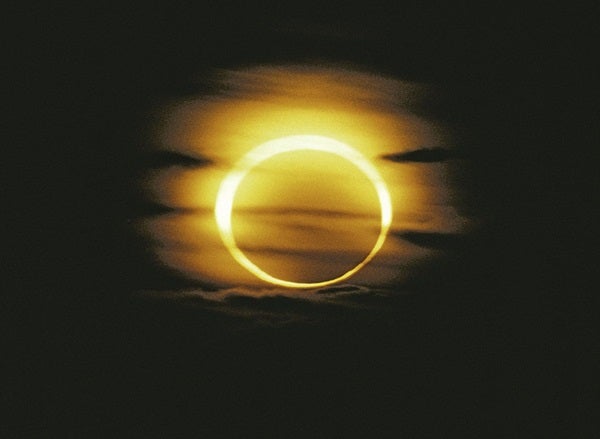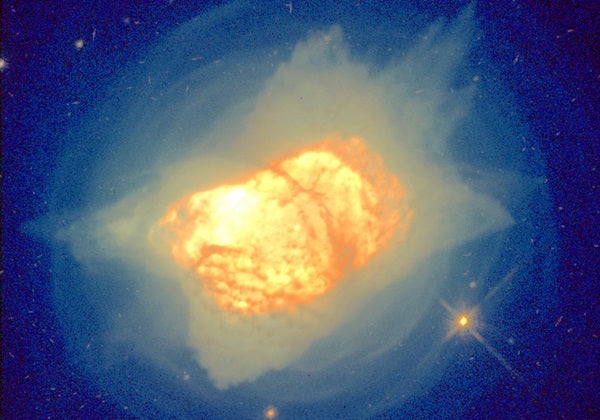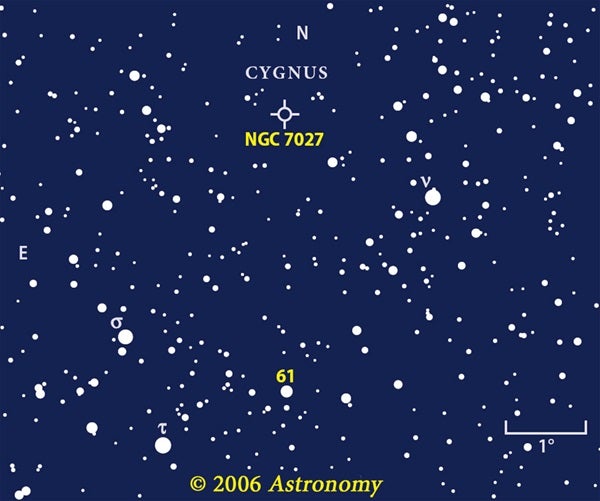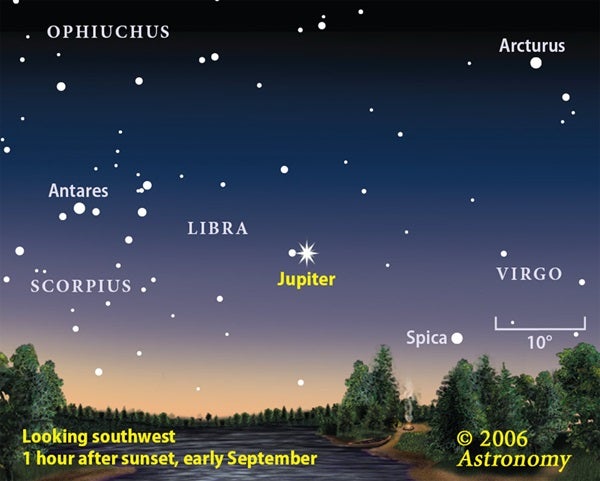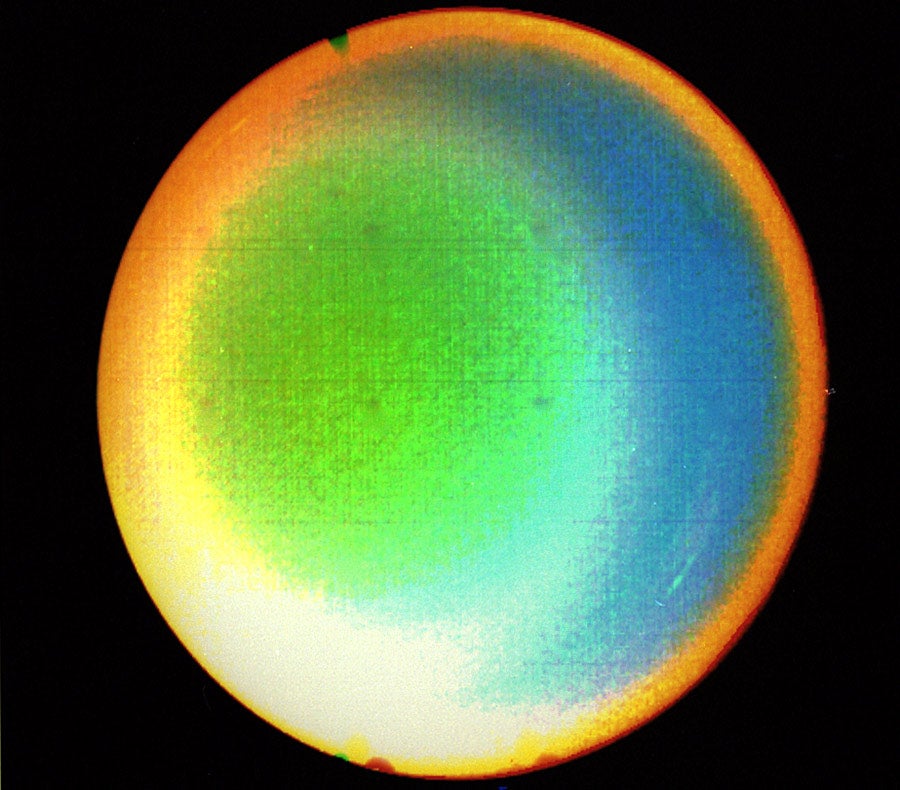The Moon’s orbit also swings high and low, like the edge of a coin spinning on a tabletop. For those in the Northern Hemisphere, the most obvious effect this summer has been the Full Moon appearing low in the south during the evening.
The “Full Moon illusion” — in which the Moon appears bigger near the horizon than it really is — can last for hours because it remains low all evening.
The high/low swing adds to the Harvest Moon effect this month. On nights following a Full Moon near the autumnal equinox, the Moon rises only a few minutes later than the night before, compared with an average of about 50 minutes later at other times of the year. (In 2006, the equinox occurs about midway between the September and October Full Moons.) In the era before floodlights on the combines, farmers used the bonus light from the nearly Full Moon to extend harvesting operations later into the evening. The farther north you live, the stronger the Harvest Moon effect. The table at right gives local daylight times of moonrise for three North American cities. Notice that in Anchorage, the Moon rises earlier with each passing night.
The September 7 Full Moon brings an added treat for observers in Europe, Asia, Africa, and Australia. That night, the Moon passes into Earth’s shadow, creating a partial lunar eclipse. At maximum, which occurs at 18h51m Universal Time, 19 percent of the Moon’s disk will be immersed in Earth’s dark umbral shadow.
The Moon’s final event of note comes at new phase September 22, when our celestial neighbor passes directly in front of the Sun. Just as Full Moon occurred near perigee, New Moon comes at apogee, so the Moon isn’t big enough to cover the Sun completely. Instead, a ring of sunlight remains visible. Northern South America is the place to be for this annular eclipse, while most of South America and western and southern Africa will see a partial eclipse. For safe-viewing tips, see “Glimpse the great ring of fire” on page 74.
Don’t let the Moon hog all your observing time. Uranus reaches opposition September 5, when it glows brightest and appears largest through a telescope. Although the planet is bright enough to glimpse with the naked eye from a dark site, binoculars or a telescope make the task much easier.
Jupiter floats low in the southwest as twilight ends in early September. The giant planet is the brightest evening object except for the Moon. Saturn appears in the east before dawn and gets higher as the month progresses.
Chances are, Jupiter and Saturn will appear blurry when you view them at magnifications above 150x. The problem — they lie low in the sky, so we view them through lots of Earth’s atmosphere. Turbulence washes away detail, so be patient, and wait for steady moments.
“I have seen the stars move.” Wouldn’t that be a cool statement to make? Even with a small telescope, you can witness stars moving. We’re not talking about the stars’ nightly, east-to-west motion caused by Earth’s rotation. Rather, we want to see stars move through space. If you choose a fast-moving star, you can detect its displacement relative to more-distant stars in less than a lifetime.
Stars close to Earth appear to move the fastest. Picture two planes: a high-flying jet and a nearby, remote-controlled model. Despite a much slower speed, the model whizzes past your head compared with the stately progress of the distant jet. In the same way, nearby objects offer the best targets for detecting movement. Although Barnard’s Star in Ophiuchus moves the fastest, 61 Cygni ranks among the top five.
With your naked eyes, you can see 61 Cygni in the upper left of Cygnus the Swan. A nice surprise awaits you when you point a telescope at 61 Cygni. Not only does it split into a pair of stars, the two components glow with a light-orange hue. From their color and brightness, astronomers deduce these stars are smaller and fainter than the Sun.
The pair takes 653 years to complete one orbit. The stars currently appear 30″ apart, a bit less than Jupiter’s apparent size. But at a distance of 11.4 light-years, this separation translates into a gap of about 100 astronomical units, or 2.5 times the Sun-Pluto distance.
In 1792 (9 years before he discovered the first asteroid, Ceres), Italian astronomer Giuseppe Piazzi noted 61 Cygni’s rapid motion. It moves 5″ per year. So, in just 6 years, the pair will move an amount equal to the current space between them. Use as much magnification as the atmosphere and your telescope will allow, and make a sketch of the pair along with nearby stars. Put your finished drawing where you can’t lose it. Then, return to the field in 5 or 6 years to see if you notice a change.
Two hundred years ago, no one knew how far away the stars lay. It wasn’t until 1838 that German astronomer Friedrich Bessel finally detected the tiny side-to-side annual wobble of 61 Cygni. This parallax gave Bessel the first rough measure of any star’s distance.
If you observe from the city, it helps to target objects with a high surface brightness because they punch through the skyglow. Planetary nebulae are good choices. Although small, their light is concentrated. You can find 8.5-magnitude NGC 7027 a few fields north of 61 Cygni. Unlike the Ring (M57) or Helix (NGC 7293) nebulae, NGC 7027 appears nearly rectangular instead of circular.
A nebula or high-contrast filter will make NGC 7027 stand out from the background. But, as long as you magnify by at least 100x, you hardly need one. An 8-inch or bigger scope brings out the nebula’s green color, although some observers describe it as more blue.
Mercury’s greatest elongation east of the Sun comes in October, but the innermost planet appears brighter in late September. On the 27th, Mercury shines at magnitude –0.4 as it passes 1.1° above Virgo’s brightest star, 1st-magnitude Spica. You’ll need clear skies and an unobstructed horizon to spot the two objects, which set about 40 minutes after the Sun. The Northern Hemisphere’s bad luck is reversed south of the equator, where the ecliptic makes a steep angle to the horizon. From there, Mercury and Spica appear 10° high some 40 minutes after sunset.
Jupiter spans 33″ and rotates on its axis in less than 10 hours. The rapid rotation and narrow observing window (Jupiter sets about 10 P.M. local daylight time September 1) means you’ll be able to see the Great Red Spot only on a few nights. From North America, the Red Spot lies on the visible hemisphere the evenings of September 2, 5, 7, 10, and 12. Although the spot also will be visible later in the month, the planet’s low altitude affects the view significantly.
One thing twilight and low altitude won’t affect much is the visibility of the four Galilean moons. Io, Europa, Ganymede, and Callisto form a chain of “stars” in line with Jupiter’s equator. Because the planet’s equator tilts 3.3° to our line of sight, however, the moons don’t always line up. As each passes in front of Jupiter, it appears to do so north of the equator. Callisto, the most distant of the four from Jupiter, passes completely above and below the planet’s disk.
Observers with 8-inch or larger telescopes can spot Pluto after darkness falls. It stands 30° high in the southwest at 9:30 P.M. local daylight time September 1. This leaves about 2 hours to search for Pluto before it dips too low. Later in the month, as this region sinks lower, the observing window shrinks. Throughout September, Pluto lies less than 1° southwest of the 3.5-magnitude star Xi (ξ) Serpentis. This convenient marker will make finding Pluto, which glows dimly at magnitude 13.9, a little less challenging.
Neptune’s cousin, Uranus, lies one constellation farther east, in Aquarius the Water-bearer. Uranus reaches opposition September 5, when it rises at sunset, climbs highest in the south around midnight, and sets at dawn. Glowing at magnitude 5.7, it’s an easy target through binoculars and shows up even to the naked eye from a dark site.
Uranus begins September 1.4° east of 3.7-magnitude Lambda (λ) Aquarii, and it ends the month just one Moon-width (0.5°) away. Watch its westward motion relative to Lambda from night to night. Uranus is moving “retrograde” — in the opposite direction from normal — because Earth is overtaking the outer planet and passing it due to our faster orbit. A small telescope will show the planet’s 3.7″-diameter disk, which glows with a distinct blue-green hue.
Saturn rises early enough during the second half of September to give nice views in a dark sky. The ringed planet shines at magnitude 0.5 and shows a disk 17″ in diameter. The magnificent rings span 38″. Saturn lies in Leo the Lion and moves slowly eastward from night to night, heading in the direction of Leo’s brightest star, 1st-magnitude Regulus. By September 30, Saturn lies 8° west-northwest of Regulus.
A smiling crescent Moon stands 9° above Saturn September 18 and sits just 4° below Saturn the next morning. A telescope at low power delivers wonderful views of the crescent Moon. Combine this with the magnificent sight of Saturn and its rings, and you’ll get the day off to an excellent start.
On September 1, Saturn lies 6° from Venus. Venus then shines at magnitude –3.7 and, through a telescope, shows an almost fully illuminated disk just 10″ in diameter. The sight of Venus near full phase was unknown before Galileo turned his new telescope to the sky in 1610. This simple observation proved profound because it supported Copernicus’ Sun-centered solar system and contradicted Ptolemy’s prevailing Earth-centered one. A fully lit Venus simply couldn’t exist in the Ptolemaic system. An even more profound realization wrought by Galileo’s studies was that observation can guide our ideas about the universe. This idea remains a foundation of modern science.
Venus will disappear from view by the end of September as it prepares to round the Sun. On September 5 and 6, Venus lies close to Regulus, passing 1.1° north of the star the first morning and moving to its east the following morning.
A thin crescent Moon sits 1° to Venus’ right September 21, almost exactly 24 hours prior to New Moon. Spying this old Moon will be a challenge, requiring atmospheric clarity and an unobstructed eastern horizon.
September nights offer a nearly unparalleled view of sporadic meteors. These apparently random bits of dust burn up in a blaze of glory when they strike our atmosphere at a few dozen miles per second. Most get incinerated at an altitude of 50–70 miles.
Part of what makes September a good month for viewing sporadic meteors is the dearth of major meteor showers. This month provides a few minor showers, however, with the Alpha Aurigids probably at
the top of the list. This shower peaks the morning of September 1, when observers at dark sites can expect to see roughly 7 meteors per hour, matching the sporadic rate.
How can you tell a shower meteor from a sporadic? The Alpha Aurigids all arrive from the same direction in space. These meteors appear to radiate from a point near the bright star Alpha Aurigae (better known as Capella), hence the shower’s name. Sporadics, on the other hand, come from random directions.
The best time to view the Alpha Aurigid shower is after midnight, when we’re on Earth’s leading hemisphere as we orbit the Sun. Auriga lies high in the early morning sky, and the First Quarter Moon sets around midnight. A secondary shower — the Delta Aurigids — peaks September 9, but the Moon is then just past full, and viewing will be difficult.
Seeing the Moon within a day or so of its new phase is a challenge that many backyard observers embrace. Viewing a slender crescent set against a multi-hued twilight sky is a sight not soon forgotten. Timing is critical for such views, and opportunities don’t arise every month at every location. The Moon must reach new phase approximately 24 hours before an evening sighting or 24 hours after a morning sighting, and it must be more than a degree or two high. Clear skies and a flat, unobstructed horizon also prove invaluable.
North American observers have a good chance this month to see an old Moon, and a bright object lies nearby to guide them. Part of the reason for the favorable circumstances is the nearly vertical angle the ecliptic makes to the eastern horizon on mornings this time of year. Essentially all of the Moon’s angular distance from the Sun translates into altitude above the horizon.
For observers in the Midwest, the Moon is 24 hours from new phase the morning of September 21. Venus, which shines at magnitude –3.8 and is easier to see, lies just 1° away then. Grab your binoculars, and carefully scan the region just to Venus’ right. Observers farther east will see the Moon an hour earlier; on the West Coast, the Moon will be 22 hours from new this morning. Venus rises about 50 minutes before the Sun, and the sky will brighten quickly. Of course, lucky observers in South America and western and southern Africa have a chance to see the actual New Moon a day later, when it appears in silhouette against the Sun’s face during an annular solar eclipse.
Barring an unexpected newcomer, autumn’s brightest comet will be 4P/Faye. It continues to brighten this month, when it should glow around 9th magnitude. Through a small scope, Faye should appear reminiscent of the fainter galaxies in the Messier catalog.
Although the comet may look similar to a distant elliptical galaxy, it couldn’t be more different in reality. Comets are small objects, only a mile or so across, surrounded by a halo of dust particles that can reach a million miles in diameter. The dust reflects sunlight, giving the comet an amorphous glow. A large galaxy, on the other hand, can span 100,000 light-years or more.
The 4P in 4P/Faye’s name means it was the fourth periodic comet to have its orbit determined, after comets 1P/Halley, 2P/Encke, and 3D/Biela. You may not recognize the name Biela because the comet disintegrated and was last seen in 1852, suffering a fate similar to Comet 73P/Schwassmann-Wachmann 3’s a few months ago. Faye has a period of 7.5 years and always stays beyond the orbit of Mars. On every second return, the comet lies on the far side of the Sun from Earth, so we can’t see it.
Generally speaking, comets appear diffuse, and their brightness spreads over a large area. This means a 9th-magnitude comet appears significantly fainter than a 9th-magnitude star. Comet Faye climbs reasonably high by midnight, so your best views will come in the last 10 days of September, when moonlight doesn’t add to the skyglow. Faye lies in Aries the Ram about 5° south of the nice double star Gamma (γ) Arietis.
As twilight fades on September evenings, the constellation Capricornus the Sea Goat crosses the meridian and appears due south. Also called a “transit,” this position marks the moment when an object appears highest in the sky and has climbed farthest above the worst atmospheric haze and turbulence.
Asteroid 6 Hebe lies in southwestern Capricornus and will be fairly easy to track with a small telescope. It currently glows around magnitude 8.5, and only three stars brighter than Hebe occupy this sector of space. On the night of September 15, Hebe slides between two of these stars, each a magnitude brighter than the asteroid.
The first asteroids were discovered in the early 1800s. Populating the zone between Mars and Jupiter, these rocky objects were given numbers in the order they were found. They also received names, usually of gods and goddesses deemed less important than those honoring the planets. In Greek mythology, Hebe is the daughter of Zeus and Hera and embodies youth and grace.

